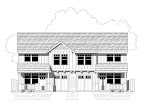Now pay attention as we mention dimension convention:
1x:
- 1x2 = .75" x 1.5"
- 1x3 = .75" x 2.5"
- 1x4 = .75" x 3.5"
- 1x6 = .75" x 5.5"
- 1x8 = .75" x 7.5"
- 1x10 = .75" x 9.5"
- 1x12 = .75" x 11.5"
2x:
- 2x2 = 1.5" x 1.5"
- 2x3 = 1.5" x 2.5"
- 2x4 = 1.5" x 3.5"
- 2x6 = 1.5" x 5.5"
- 2x8 = 1.5" x 7.25"
- 2x10 = 1.5" x 9.25"
- 2x12 = 1.5" x 11.25"
- 2x14 = 1.5" x 13.25"
- 3x4 = 2.5" x 3.5"
- 3x6 = 2.5" x 5.5"
- 4x4 = 3.5" x 3.5"
- 4x6 = 3.5" x 5.5"
- 4x8 = 3.5" x 7.25"
- 4x10 = 3.5" x 9.25"
- 4x12 = 3.5" x 11.25"
- 4x14 = 3.5" x 13.25"
And while we're at it, how about some typical engineered wood sizes.
I-joists are created by standing a piece of OSB or plywood upright and capping it with a 2x flange. The result looks like a capital serif 'I' hence the name.
I-joist flange widths (varies by manufacturer):
- 1-3/4"
- 2"
- 2-5/16"
- 3-1/2"
- 9-1/2"
- 11-7/8"
- 14"
- 16"
- 18"
- 20"
- 22"
- 24"
LVL widths:
- 1-3/4" (2 layers)
- 2-5/8" (3 layers)
- 3-1/2" (4 layers)
- 5-1/4" (6 layers)
- 7" (8 layers)
- Any height possible though generally intended to match I-joist material. Can match dimensional as well.
Glu-lam beams are created by gluing and compressing several layers of post milled dimensional lumber together. The whole beam is then planed again to create an even surface. For this reason, glu-lam beams are slightly narrower than dimensional lumber. *The industry has recently changed to also offer Gle-lams in full 5-1/2" widths as well. Heights are always in multiples of 1-1/2" due to the size of the plies. *The industry has recently changed to offer heights that are consistent with solid sawn and engineered lumber as well. Due to general engineering practice the height should always exceed the width though rare exceptions always exist.
Glu-lam widths:
- 3-1/8"
- 3-1/2"
- 5-1/8"
- 5-1/2"
- 6-3/4"
- 7-1/4"
- 8-3/4"
- 9-1/4"
- 10-3/4"
- 6"
- 7.5"
- 9"
- 9.5"
- 10.5"
- 11.875"
- 12"
- 13.5"
- 14"
- 15"
- 16.5"
- 18"
- 19.5"
- 21"
- 22.5"
- 24"






No comments:
Post a Comment